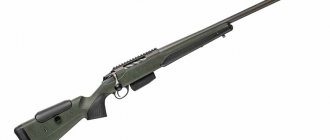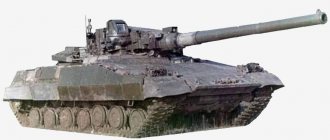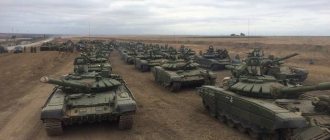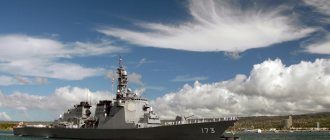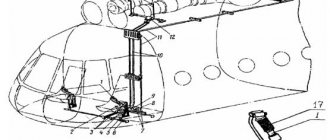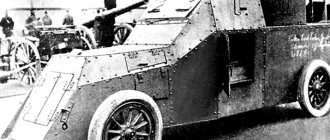At the end of 2022, the general director of the Military-Industrial Company, Alexander Krasovitsky, announced several important news. The unified wheeled platform “Boomerang” has completed a cycle of factory preliminary tests and is ready to enter joint state tests, after which it should be put into service. So far, two vehicles are being prepared - the K-16 armored personnel carrier and the K-17 wheeled infantry fighting vehicle. But in the near future, a whole line of combat and special vehicles should appear on this base.
The armored vehicle is taller than the main T-72 tank, and its weight reaches 32-35 tons. These impressive forms confuse many.
(Photo: Vitaly Kuzmin)
Such a big armored personnel carrier - even a blind man could get into it! Why wheeled armored vehicles the size of a house when there is the BTR-80 - low-profile and fast? Maybe modernize the good old BTR-80, like, for example, the highly tuned BTR-82AM presented at Army 2019?
Is a low pelvis pleasing to the eye?
Skeptics still doubt the usefulness of a wheeled armored personnel carrier with dimensions slightly inferior to the Armata. They say that even an elderly Volkssturm soldier with cataracts and a first-model Panzerfaust will not miss such a “barn.” At night. Moonless. In a snowstorm.
Are dimensions really that critical for a combat vehicle in the first quarter of the 21st century?
A little history. The main wheeled armored personnel carrier of the Russian army, the BTR-80/82, traces its ancestry directly to the BTR-60. At first, the four-axle vehicle satisfied the parameters of the Cold War doctrine (not the BTR-152, which is already good) - transporting soldiers to the battlefield at a decent speed, protecting them from flying shrapnel or machine-gun fire from an ambush. Many solutions were compromises: pairing car engines from the 51st “lawn” (there was not a sufficiently compact and powerful one at hand); thin armor 5-9 mm, but at rational angles of inclination; open top.
Then they thought that sparkling helmets against the backdrop of bright “mushrooms” from explosions of nuclear charges was not very good for the health of Soviet motorized riflemen. Therefore, they made a roof and a turret for twin machine guns (BTR-60PB). All this is dictated by the needs of a massive multi-million army and the capabilities of industry.
But what were advantages became disadvantages over the years. Thin armor and fire-hazardous gasoline engines already played their fatal role in Afghanistan. The growing mine war forced the infantry to climb onto the roof. When a mine explodes, there is a chance that you will fly to the side, and in a cramped iron box - certain death.
Sniper bullets? Neglect! Mines are worse
And no matter how you modernize the armored personnel carriers of this family, installing a diesel engine, adding 30-mm cannons, thickening (slightly) the armor, introducing anti-fragmentation lining and modern aiming and observation means, in hot spots Russian soldiers on the march will invariably climb onto the armor.
BTR-80, BTR-82, BTR-82AM, BTR-82AT - no matter how many letters you put on the index, vehicles of this family are obsolete and are not suitable for the conditions and tasks of modern wars. In short, countless modernizations lead to a dead end.
Syria. It’s more familiar on armor, but is it safer?
The new generation vehicle allows us to provide a different level of protection, both from mines and from small arms and even from large-caliber machine guns and automatic cannons. And now they strive to install a large caliber on every rusty pickup truck. The BTR-82 simply cannot provide protection against them. What can I say: it hits the side and an armor-piercing rifle bullet from medium distance is no longer very good.
Barn? No, we haven't heard. Armored personnel carrier Vilkas (nee "Boxer") of the Lithuanian army
It’s just easier to get into an armored personnel carrier from an autocannon or DShK than from a grenade launcher. Let us recall the tabular and practical indicators of the firing range of the RPG-7. What about a moving target? This is truly a sniper and filigree work, for which you still need to seriously shine the carcass from behind cover.
For modern high-precision weapons, gaining a couple of tens of centimeters in size means almost nothing. And optical-electronic suppression, dynamic protection and active protection systems (APS) can save you from being hit by ATGMs. In the development of the latter, unfortunately, Russia is losing the palm - in the West, KAZs are actively being developed and are planning to be installed almost on trucks. Recently, the US Army took two systems - Israeli and German origin - for comparative tests for subsequent equipping with them various types of armored vehicles.
On the BTR-82, a V-shaped mine-resistant bottom will not work, but on the Boomerang it will work. The same thing - a suspended floor and energy-absorbing chairs for paratroopers with shock absorption and individual suspension.
In conditions when 70% of the losses of regular armies in local conflicts are due to mines and IEDs, this is a necessity.
The Boomerang finally got rid of one of the main problems of Soviet armored personnel carriers - the lack of a stern outlet. Doors on the sides and hatches on the roof clearly never contributed to a safe landing. And sometimes the vehicle itself has to provide a weak side to cover motorized riflemen.
BTR 82A photo of the new armored personnel carrier of Russia
BTR 82A photo is a new armored personnel carrier of Russia , the most modern to date and in service with the Russian army, the successor to the famous BTR-80. Looking ahead a little, the new Russian armored personnel carrier “Boomerang”, which is expected to be shown at the Victory Parade in Moscow, their appearance and characteristics are still kept secret; they have not yet entered service with the troops. However, you can learn something about them at the end of the article.
An impressive photo of the BTR 82A shows the ability of the automatic cannon to work against air targets
A little about the BTR-80 (it has been produced since the mid-eighties) is produced by the Arzamas Machine-Building Plant, which also produces the Tiger car photo . At the end of the 2000s, a promising BTR-90 was developed, which was called a “wheeled tank”: it is much more powerful than conventional armored personnel carriers, better protected and armed. But the “nineties”, firstly, turned out to be tall (from the military point of view, it is a “target for a grenade launcher”, although one of the most numerous foreign analogues, the Piranha armored personnel carrier, also cannot boast of a low silhouette and nothing!), and secondly , remained the classic successor to the Soviet armored personnel carriers with their shortcomings.
- inconvenient entry and exit of motorized rifles along the sides of the armored hull - can you imagine what it’s like to get out of there “in full combat mode,” and even under enemy fire? True, the exit “at the stern” (like its foreign counterparts) has its drawbacks - if, say, the convoy is ambushed and an enemy machine gunner approaches from behind.
- All previous armored personnel carriers, including the “ninetieth”, were created without the expectation of a powerful explosion - although the increase in the height of the “ninetieth” is associated precisely with an attempt to solve this problem (the weakening of the blast wave is proportional to the cube of the distance from the explosion site to the vehicle body). But today even the Bulat SBA-60-K2 KAMA3 wheeled armored vehicles, the relatively small 53949 Kamaz Typhoon and the Typhoon Ural 63099 family of armored vehicles can withstand an explosion of 8 kg of explosives!
Therefore, although the Russian Ministry of Defense adopted the BTR-90 for service in 2008, it did not purchase it - but instead announced the start of development of a completely new Boomerang family. In the meantime, it was decided to thoroughly modernize the familiar BTR-80. The modernized model was assigned the BTR index 82 . In 2010, the “eighty-second” were published, and in 2013 they were put into service.
- BTR 82 is armed with a heavy machine gun
- The BTR 82A is armed with an automatic cannon caliber 30 mm 2A72 (Shipunov and Gryazeva), exactly the same as on the BMP-3 and BMD-4.
photo armament BTR 82a automatic cannon 2A72 30 mm caliber and PKTM machine gun 7.62 mm caliber
Read this carefully . I don’t know why, but on the Internet they are looking specifically for information on the BTR 82A photo of the new armored personnel carrier of Russia , specifically modifications with index A. Probably due to the fact that the “cannon” BTR-80A also exists, but it is not common in our army. The main combat vehicle of motorized riflemen is still the usual “eighty”. As for the new information on BeTeeR 82A, it is constantly changing, so what you read is already outdated. According to the manufacturer, during 2010, 191 changes (!) were made to the design of the BTR-82/82A, in 2011 - already 210 (!), in 2012 - 250 (!), and in 2013 - 280 (!). Total - almost a thousand changes in four years! Do you still want to be updated? and watch Wikimedia! Do not make me laugh. Look at the video, I collected it bit by bit. The current emphasis is on "Ashka" with a cannon, why...? The conflict in, or in Ukraine, what the hell is the conflict, WAR (the largest in Europe, since the Second World War using multiple launch rocket systems "MLRS" and heavy weapons) showed the weakness of tank protection (!) What can we say about transporters (armor most of them are eliminated by a small arms bullet (!)) and the loss of the possibility of effective massive use. Its role on the battlefield has fundamentally changed (and the same for armored personnel carriers, not only to bring, but to take away the crew and troops intact). “Tank avalanches” in the distant past, today a tank, armored personnel carrier, or infantry fighting vehicle has become a small-group or single means of fire support, something like a sniper with armor and the ability to quickly maneuver. In general, it’s great if you’re outside the zone of effective enemy fire.
Armored personnel carriers of the Kharkov plant intended for the National Guard of Ukraine are planned to be delivered in total to about a hundred
Whoever uses cars like this is on a horse, in relation to Ukraine, DPR and LPR. By the way, they have their own “independent” armored personnel carriers.
"Little green men" under the cover of an armored personnel carrier 82A enter the territory of the air base in Belbek (Crimea). Pay attention to the excellent equipment of Russian soldiers.
In the photo - just a serial BTR-82A, serving in one of the military units of the Russian army. What are the differences here from the usual “eightieth”? Do you see the long trunk? Instead of the usual KPVT machine gun, there is a 30 mm automatic cannon. The Tula-made gun has a stabilizer and two firing modes:
- automatic - against ground targets
- “semi-automatic” - by air.
- The firing range is 3.6 km against infantry and 2 km against armored vehicles. Seriously!
- Ammunition - 300 shells
sight and day-night fire control system TKN-4GA 01
The presence of a sight and a day-night fire control system TKN-4GA 01 (it is produced in Rostov) is stabilized in two planes and an electric drive for turning the turret (its official name is “combat module”) - previously on the 80th you need was to turn the knobs. On the BTR 82A photo , there appeared an autonomous diesel generator set with a TMZ-520D diesel engine, a power of at least 5 k8t (it powers the electrical system when the engine is turned off), an automatic fire extinguishing system and a “mine-resistant” flooring on the floor, designed to reduce the effect of a shock wave during an explosion . Observation devices - commander's combined device, day vision devices (3 pcs.), night vision devices. And it can be equipped to order - you’ll never guess with what, air conditioning , when this happened on Soviet-Russian equipment.
BTR 82A photo, adopted for service in 2013
BTR 82A photo Russia's new armored personnel carrier has become almost two tons heavier compared to the usual “eightieth”, as a result, both the chassis and the engine and transmission had to be changed. The old “70s” had two GAZ gasoline engines: of course, now a turbodiesel produced by KAMAZ is located in the engine compartment. In the “eighties” it develops 260 hp, but here it’s already 300 hp. The engine, as before, is multi-fuel (that is, it “digests” even diesel diesel fuel) and, as befits diesel engines, is equipped with a pre-heater for starting in cold weather. By the way, it’s warm in the armored vehicle - you can’t call it a “refrigerator”.
covers covering the engine compartment
Photo of the engine compartment of the BTR 82A, 300-horsepower KAMAZ turbodiesel, the cooling system radiator is located at the very rear
Access to the “engine room” is closed by engine compartment covers on the “deck”; under them there is a hefty turbodiesel, in the collapse of which a mechanical injection pump (high pressure fuel pump) and an air compressor are visible. If during repairs or maintenance something falls to the bottom of the armored hull, it will be very difficult to get it out. But “Batars are reliable. To the KAMAZ engine! - no complaints. Fuel consumption on the highway is very modest - 38.5 l/100 km (of course it increases off-road).
In the collapse of the block there is a regular fuel injection pump familiar to all Kamaz drivers, unfortunately I don’t know what determines its multi-fuel capability, and there is a photo of a turbocharger for each row of cylinders
The “iron” interior, low seat, old-fashioned steering wheel, long “poker” gear shift... together with the cramped driver’s workplace were completely migrated from the BTR-80. It's cramped, very cramped. If the driver is injured or killed, it is almost impossible to remove him from his seat! In the BTR 82A photo, the new Russian armored personnel carrier is exactly the same. And visibility to the rear is no better: the view through the mirrors (and they are here) can only be seen through the narrow slits of the side triplexes - or you can drive “in a camping manner” by sticking your head out of the hatch.
photo of the driver's seat of the BTR 82A, Soviet ergonomics ala 80s
photo on the left - control units of the armored personnel carrier afloat, on the right - tire inflation unit
The gear shift pattern in the five-speed box is inverted (the first is at the bottom, the second is also at the bottom, but the third is at the top). Starting the engine with a button, not to be confused with keyless start ;-). You need to start from the second one. The elasticity of the engine is such that the “third” is quite enough on a bumpy snowy field. And in general, the characteristics of a turbodiesel, not strangled by European standards, and an improved suspension are impressive. A 15-ton, and even eight-wheeled, SUV allows you to “light up” so much and “tumble” into corners so confidently! With cross-country ability, everything is excellent; now all axles have conical differentials with forced locking, and not self-locking cams, as before. The front axle drive, as before, is disabled - on the highway and light off-road.
this is what the triplexes of an armored personnel carrier look like, next to the commander’s seat there is a holster attached to the side
Benches for landing troops and anti-traumatic chairs will probably be in the “Boomerang”
The mileage of an armored personnel carrier before overhaul is 50 thousand km, but it is an armored vehicle. There is also a significant drawback: the heavier armored personnel carrier has become worse at sailing at sea, and there have already been several cases when such vehicles sank during waves... However, global trends are such that armor protection is the basis, and buoyancy is often sacrificed.
armored personnel carrier 82a is firing a machine gun, the gunner of the module is located outside the protruding turret
BTR 82A is armed with an automatic cannon
Tactical technical characteristics of the BTR 82A photo of the new armored personnel carrier of Russia
- Model BTR-82A total combat weight 16 tons
- Combat crew, crew 3 (commander, gunner-operator, driver), landing party 7 people
- Engine KAMAZ-740.13-ZOO max, power, hp. 300
- Gearbox: manual, five-speed
- The suspension is independent torsion bar, with 12 shock absorbers (two each in the wheel suspensions of the first and fourth axles, one each in the suspensions of the second and third axles).
- Tires KI-126, tubeless, fire-resistant
- Maximum speed on the highway is at least 80 km/h, afloat 9 km/h
- Estimated cruising range on land is at least 700 km
- afloat for at least 12 hours
- Overcoming max. angle of ascent 30º ditch 2 meters wide ledge 0.5 meters high
- armament of the 82a armored personnel carrier: automatic 2A72 cannon of 30 mm caliber and a PKTM machine gun of 7.62 mm caliber
- Ammunition: 300 rounds for the cannon and 2,000 rounds for the machine gun
Does this mean that the developers have squeezed everything possible out of the armored personnel carriers, which, by the way, were born in the Soviet Union? No matter how it is! Since there are enough orders (including from abroad: the VPK company, which owns the Arzamas Machine-Building Plant, exports armored vehicles to fifty countries around the world), the developers are constantly improving the design. In perspective:
The interior of the promising BTR-88, a video sight and aiming joystick are visible
- - even deeper modernization, installation of an autonomous module with weapons, where the target must be aimed remotely using a joystick, looking at the video screen.
- The model was already shown to the military last summer, at first it was assigned the index “ product 82A1 ”, but, according to the manufacturer, it will be changed to BTR-88 . It will be armed with a remote-controlled module of the Burevestnik Institute with a 30 mm cannon and a PKTM machine gun.
As promised, now about the new Russian armored personnel carriers “Boomerang” which I wrote about at the beginning, their appearance and characteristics are still kept secret, but what they are can be guessed. The main drawback of the previous generation, which I previously kept silent about, is the complete absence of highly specialized armored personnel carriers, that is, we often see the use of ordinary army vehicles in special operations. Hence the conclusion.
- Modular design allows the production of various versions (military, commander or sanitary, etc.).
- A different layout that allows exit from the troop compartment at the rear.
- The landing compartment itself is more spacious and with energy-absorbing seats, about the same as on the Ural Typhoon, and maybe better.
- Accordingly, explosion protection is much higher than now.
- Improving armor protection (probably using domestic ceramics).
- All this will lead to weighting, and accordingly to an increase in engine power.
- It was expected that “Boomerangs” would be shown on May 9 this year, at the Victory Parade in Moscow, but, according to military news agencies, the debut will be postponed: they do not have time to prepare the experimental batch for the holiday.
armored personnel carrier BTR 82a
In the meantime, on guard - BTR 82A photo of the new armored personnel carrier of Russia . With a gun, a night sight...
Two and a Half Diggers
Another point that is traditionally treated with disdain in both the USSR and Russia is ergonomics.
If you compare a Soviet motorized rifleman from the 60-70s and a modern fighter in the “Warrior” kit, it is easy to notice that a soldier of the 21st century carries more equipment, which means that the volume of the fighting compartment is required more. And a modern officer or contract soldier (which is two-thirds of the army) will be heavier than an 18-year-old conscript.
Let’s not mention here the armor of modern sappers and fighters of the assault and barrage battalions - it’s just the ultramarines from Warhammer resting there.
Help the soldiers of the assault and clearing battalion get into the BTR-82A (photo: Grigory Milenin)
Even if we push in all this body-positive brethren, will the soldiers reach the battlefield in sufficient physical condition for battle? Hardly. This is a worldwide problem and they solve it with more spacious, and therefore larger, equipment like the same American “strikers” (which have already undergone several modernizations, increased in size and almost doubled in weight), German “boxers”, Italian “Frecchia” and so on Further. A modern motorized infantry squad is heavier, more protected, and has more teeth in its weapons. There are never too many cartridges and grenades either.
Boomerang effect
Nowadays, an armored personnel carrier is not only a linear vehicle, but also the unified line that invariably follows it - wheeled tanks, command post vehicles, ambulances, evacuation vehicles, self-propelled mortars, air defense systems... and much more. One platform is convenient both from the point of view of supplies and repairs, and from the point of view of tactical mobility (it’s not good when our mortars lag behind or “medics” cannot enter the counterfire zone).
A linear armored personnel carrier is only the tip, a knight, followed by a whole “spear” of squires, archers and other assistants. Otherwise, we will soon run out of both equipment and soldiers.
BTR K-16 platform "Boomerang"
Are you saying that there are also special vehicles based on the 80s? There is, of course, but the narrow “armored coffin” of the BTR-80 imposes serious restrictions on the deployment of the entire combat system of a motorized rifle brigade at its base. Even the installation of a module with a 30-mm cannon on the BTR-80A was accompanied by a lot of problems associated with the accuracy of the gun, dispersion due to longitudinal swing and placement of sufficient ammunition. What can we say about heavier weapons?
But “Boomerang” is so heavy, that’s why it’s probably slow and clumsy! And Soviet armored personnel carriers can also swim!
The latest, hopefully, iteration of the BTR-82AM weighs as much as 15 tons, but this is the limit for the 300 hp engine. With. The Boomerang has a multi-fuel diesel engine YaMZ-780 with a power of 750 hp. s., which may not be considered the limit for a 35-ton machine. It turns out that the specific power is 24 hp. With. per ton at maximum weight versus 18-20 liters. With. for BTR-82, for BMP-2 - 20 l. With. Yes, the Boomer’s thrust-to-weight ratio is higher, despite its almost tank-like mass.
And the funniest thing is that “Boomerang” also knows how to cross water obstacles by swimming. The ability to swim in general was a fixed idea of the Soviet armored doctrine. But this directly stemmed from the need to cross many European rivers and streams in a rush to the English Channel amid atomic explosions, plus psychological trauma and nightmares of generals since the Great Patriotic War. Nowadays, combat breaststroke swimming of entire units without appropriate pontoon equipment is hardly imaginable.
They have a gun. They're going to shoot it!
In its basic version, the K-17 BMP is armed with a universal Epoch module with a 30-mm automatic cannon, a machine gun and four launchers for ATGMs, as well as various clever optical-electronic viewing and guidance units. Such modules, by the way, are suitable for both the promising Kurganets-25 tracked infantry fighting vehicle and the T-15 based on the Armata.
Combat module "Epoch"
But the Boomerang platform can afford more. For example, a turret with a 57-mm automatic cannon “Baikal” and its development “Dagger”. Why is it needed? Such a gun can successfully hit not only militant pickup trucks and infantry fighting vehicles, but even a main battle tank can seriously offend its side projection.
Isn't it redundant? In our century, many infantry fighting vehicles and armored personnel carriers have long jumped beyond the weight of 30 tons. The armor is strengthened, and for a confident defeat you need larger guns - and the combat distances increase. If previously a 20-25 mm gun was the standard for Western infantry fighting vehicles, now calibers of 30-35-40 and even 45 mm are not at all uncommon: a 40 mm gun with telescopic shells is found in the French Jaguar reconnaissance vehicle, and the Americans they plan to put a 50-mm cannon even on the Ripsaw robot heel.
In principle, the line between armored personnel carriers and infantry fighting vehicles is gradually blurring. And the driver here is not as important as the tactical niche. In terms of fire and protective characteristics, armored personnel carriers are approaching infantry fighting vehicles, and the functions of the former are taken over by light armored vehicles and MRAPs. Even minibuses to the front are becoming more and more thick-skinned and mine-protected. And infantry fighting vehicles and armored personnel carriers themselves are gaining more and more functions and often operate without tanks and not in their interests.
(Photo: Katzennase)
Abroad, some machines have even reached the highest degree of versatility. The German Boxer module can be replaced in the field and change the purpose of the vehicle.
Description of the machine
Today we do not have comprehensive information about the characteristics of the Boomerang armored personnel carrier. There is only scattered information. Based on it, we will try to introduce you to a new armored personnel carrier.
It is known that the weight of the new vehicle is about 20 tons, while some of the modifications created on the basis of the Boomerang will weigh up to 25 tons, thanks to increased armor protection. The power compartment is located in the bow of the vehicle, increasing the protection of the armored personnel carrier from explosions and frontal enemy fire. The landing hatch is located in the aft part - the most protected during battle. The volume of the landing compartment has been significantly increased compared to vehicles developed in the USSR. In those days, body armor was not practically used, so soldiers needed less space. A modern soldier has much more weapons and ammunition, so he needs more space. And it takes less time to leave a more spacious car, so in this case size is not only a matter of convenience, but also safety.
When creating the Boomerang armored personnel carrier, multilayer armor was used, which included ceramics. This type of armor is much more effective than conventional homogeneous armor and has never been used before in the creation of light armored vehicles. It is usually used when creating tanks. The main distinguishing feature of multilayer armor is its high efficiency against cumulative ammunition. According to the technical specifications, the frontal armor of the Boomerang must withstand small-caliber artillery fire, the vehicle must withstand being hit by an anti-tank grenade from any direction, as well as heavy machine gun fire.
It is still unknown which engine was used to create the Boomerang armored personnel carrier; we do not know its power and other characteristics of the power plant. One thing should be said with confidence - this engine is definitely more powerful than that of the BTR-80. Considering the rather serious weight of the Boomerang, it should also have a more powerful engine. Most likely, the power will be more than 600 horsepower.
The new armored personnel carrier retains the traditional 8x8 wheel arrangement. It can float; propulsion through water is provided by water jet engines mounted on the rear of the hull. There is no information yet about the speed that the new car can reach.
The vehicle that could be seen at the parade in Moscow is armed with a 30-mm 2A42 automatic cannon, a PKT machine gun and an anti-tank missile system that fires Kornet guided missiles. The weapons are assembled into a single combat module, which is controlled remotely. The automatic cannon's ammunition capacity is 500 rounds. Both the vehicle commander and the operator-gunner can fire. The ammunition is securely isolated from the members of the landing group and the crew.
However, so far we have only seen one variant of weapons that can be installed on the Boomerang. This combat platform can be equipped with various types of weapons.
On the basis of this “Boomerang” they plan to create a mobile anti-tank complex, an infantry fighting vehicle, a wheeled tank, an armored personnel carrier, and many types of special vehicles. They will all differ in their weapons.
The armored personnel carrier will likely be equipped with the latest surveillance and fire control systems. Most likely, these vehicles will be included in a unified tactical-level control system, which will allow the commander to see the vehicles on the battlefield online.
It is still difficult to give a final assessment of the new car. We are waiting for official information to appear about its performance characteristics and its cost.
Fire and wheels
As already mentioned, the Boomerang base can become the basis for the creation of command post, repair and evacuation, ambulance vehicles, as well as self-propelled mortars, howitzers and even wheeled fire support tanks with a 125-mm cannon in the turret.
Thus, on a unified base, it is possible to equip motorized rifle brigades with equipment, which will not only be more protected, but also tactically much more flexible and mobile.
For some reason, we tend to treat wheeled vehicles more leniently: they say, the main thing is the tracks. But wheels are now not much inferior to tracks in terms of maneuverability. And in terms of tactical mobility and engine life, they are far superior to them.
The maximum speed of the Boomerang on the highway exceeds 100 km/h. On a dirt road - 92 km/h. The BTR-80 accelerates to a maximum of 80 kilometers per hour, and the BMP-2 to 65. And on rough terrain, the wheeled Boomer is not at all inferior to the tracked Beha - driving at 50 km/h is allowed.
Not to mention the fact that it is better to transport tracked vehicles over long distances by trailers or even by railways, on which the mobility of motorized infantry units in our country traditionally depends. Even in the event of a “small” war, it is easier to cut a piece of iron than a highway. And the wheel brigade has enough highways and country roads.
K-17 infantry fighting vehicle on the Boomerang platform (photo: Vitaly Kuzmin)
As for mobility, the French, in their Scorpio ground forces development program, talk about combat marches of up to 500-800 kilometers.
Most practicing military theorists predict the war of the future as a multi-medium, mobile confrontation - and the main combat operations will also take place in cities and urbanized suburbs. So the more versatile and multifunctional the vehicle, the greater the chance of a motorized rifle unit to survive and win. The concept of a “minibus to the battlefield” is completely and irrevocably outdated. There are practically no front lines, but mines, anti-tank systems, ambushes and raids have become the hallmarks of almost any conflict.
And the versatility of the “Boomerang” is not only in its different modifications, but also in its modular reservation scheme and the ability to install dynamic protection and active protection systems on it, without which it will be difficult to withstand the abundance of anti-tank systems.
Speaking of anti-tank systems. They are used more and more actively and not only against tanks and infantry fighting vehicles, but even against unarmored vehicles, fortified firing points and even individual enemy soldiers. In the Middle East, there has even been a phenomenon of mercenary units of experienced anti-tank missile system operators who are hired by various jihadist groups to knock out enemy armored vehicles. And the lattice screens on the BTR-82AT look like an ineffective solution against such threats.
It was smooth on paper
Everything seems to be clear, and armies all over the world are either serially equipped with modern wheeled armored vehicles, or such equipment is being actively developed - even in the “second echelon” countries. Turkey, Singapore and Serbia are sawing their own heavy armored personnel carriers, not to mention the USA, Germany, France, and Italy. We went from the “Boomerang” ideas to tangible results only by 2022. Throughout the 90s and early 2000s they tried to get a “stone flower” from the same old Soviet family. First there was the “bloated” BTR-90 “Rostok” and work on the R&D “Gilza”. The first was finally abandoned only in 2011, while still managing to be formally adopted. At the same time, the project for the future “Boomer” was approved.
BTR-90 with BMP‑3 turret
The military was eager to receive a new platform already in 2013, and a series in 2015. But the deadlines were constantly shifted due to shortcomings and dissatisfaction of the military with certain characteristics. And despite the fact that prototypes were shown at the Victory Parade in 2015, the development of the car continued for another four years. Now they promise a series in 2022, but, as the experience of the world and especially the Russian defense industry says, time is stretchable.
Appearance of an armored personnel carrier based on the Gilza design and development (photo: Alexey Khlopotov)
Over the course of several years, “Boomerang” underwent many changes and improvements, after which it was possible to greatly reduce the price (according to the official statement, three times) for the final product. A rather strange message - either the cost was initially greatly inflated, or the Bumer in serial production will be much poorer in terms of “stuffing”.
As Defense Minister Sergei Shoigu recently noted, partly due to the shift to the “right” of a number of ambitious programs such as the Kurganets infantry fighting vehicle, the Boomerang armored personnel carrier and the Armata tank, the level of rearmament with modern equipment of the ground forces continues to remain the lowest in the armed forces. Meanwhile, the deadlines for entering the GSI are constantly shifting. And “boomerangs” are needed yesterday.
But the Airborne Forces are actively equipped with the latest jumping equipment, where the BMD-4M costs almost like a brand new T‑90.
But for now, the basis of transport for our motorized riflemen is still the Soviet BMP-2 and strange BMP-3, as well as various modifications of the BTR-80. It got to the point that they decided to upgrade the BMP-1 to the level of the “Basurmanin” with a remotely controlled module.
BMP-1AM "Basurmanin" (photo: Vitaly Kuzmin)
Continuous palliative solutions against the backdrop of “boxers” and “patrias”. And soldiers in Syria still ride “on armor”, and not inside it, because the fear of being blown up by a mine is greater than being shot by a sniper. And no matter how much you smear the BTR-80, it remains a conceptually outdated vehicle. This is the level of preparation not even for the last war, but for the one before that.
But mass production, unfortunately, is not yet a panacea. The main thing is to create connections on a new platform and equip them with the entire line of machines necessary for this, and not to distribute a pair of earrings to all sisters. The success of a technique depends not only on the technique, but also on the strategy and tactics of its application. And of course, the training of personnel and understanding of their own maneuver - for which there are hundreds and thousands of evidence in the history of military operations.
Updated and new. Development of the Russian tank fleet
The Russian army has many tank units and formations that form the basis of its striking power. The main battle tanks in service are a number of models and modifications - both basic types and those that have undergone modernization. It is also expected that new equipment with special capabilities will be adopted. Let's consider the current state of affairs and prospects for tank forces.
T-72B3 and its crew during exercises. Photo by the Russian Ministry of Defense / mil.ru
Total number
Tank units and subunits are present in all combined arms armies of the ground forces, and are also present in the coastal forces of the navy.
These can be tank regiments and brigades as part of armies, or battalions or companies as part of motorized rifle formations. Tanks are present in all strategic directions. Current figures for the size of the Russian tank fleet are not officially published. Unofficial open sources contain a variety of estimates. Thus, the authoritative IISS The Military Balance directory indicates that the Russian army has a total of about 13 thousand tanks of all types in service and in reserve. The authors of the Global Firepower military rating give other figures. According to them, Russia has almost 22 thousand tanks.
At the same time, the majority of the total number consists of tanks in storage. According to The Military Balance, more than 10 thousand armored vehicles remain in reserve, while the active fleet of tank units does not exceed 2,800 units. This amount of equipment allows us to arm all tank units and ensure the required combat capability of the army.
Having a large reserve has its advantages. If necessary, these tanks can be returned to service. In addition, some projects involve the restructuring and modernization of equipment from storage and do not affect combat vehicles.
Equipment for modernization
Currently, the Russian army has tanks of three models and several modifications. Before the start of the current modernization programs, T-72, T-80 and T-90 MBTs of different versions were operated. The bulk of the tank fleet consisted of T-72 vehicles of various modifications - about 2 thousand units. About 6-7 thousand more of these tanks are in storage.
Modernized T-90M. Photo by NPK Uralvagonzavod
Less numerous are the MBTs of the T-80 family - no more than 400-500 “active” units and up to 3 thousand in storage. The T-90 was the least widespread in the past - about 550-600 of these tanks were built for our own army. Approx. remains in service. 350 units.
MBTs of existing types are generally capable of continuing to serve, but their characteristics no longer fully meet current requirements. In this regard, the army has launched several equipment modernization projects. With their help, it was planned to significantly update the fleet of equipment at reasonable and acceptable costs.
At the turn of the last decades, a modernization project for the T-72B MBT with the index “B3” was created. The reconstruction of equipment for this project began in 2011 and is still ongoing. In 2016, a new version of the T-72B3 modernization was developed with new changes and improvements aimed at further improving performance.
In the mid-1990s, development of the T-90M “Proryv-3” project began. He offers replacement of the power plant, strengthening of protection and installation of a new fire control system. To date, the design has been completed, the modernized tanks have been tested, and the project has received approval from the Ministry of Defense. Serial modernization of the T-90 and T-90A combat tanks has already been launched.
The army has several hundred T80B and T-80BV tanks, the operation of which can continue after a certain upgrade. For this purpose, a modernization project for the T-80BVM was developed, offering increased protection and an update of the control system. The first contract for a new type of equipment appeared in 2022. In 2018, the army received the first batch of repaired and modernized T-80BVMs.
The pace of modernization
In the past, the relatively low cost of rebuilding the tank was cited as an argument in favor of the T-72B3 project. Overhaul and re-equipment of the serial T-72B were noticeably cheaper than the construction of a new T-90A with the same combat characteristics and qualities. Optimal economic indicators allowed the army to launch a full-scale serial modernization, the results of which are of great interest.
One of the first T-80BVM. Photo Decoder / otvaga2004.mybb.ru
According to various sources, since 2011, at least 1000-1100 tanks from combat units have been upgraded to T-72B3. The bulk of this quantity has been updated according to the original B3 project. At least 150-200 tanks were upgraded to T-72B3 mod. 2016. At the same time, the number of T-72B3 in the troops is constantly increasing. The army decided to rebuild almost the entire existing T-72B fleet.
The first order to modernize the T-90(A) to the T-90M state appeared back in 2022. It provided for the repair and renewal of 20 combat tanks. The military also wished to receive 10 new T-90M tanks. Two more contracts of this kind were concluded in 2022 and 2019. The Ministry of Defense may place new orders in the near future.
According to official and unofficial data, the contracts provide for the supply of 160 T-90M MBTs. A quarter of this number will be built anew, and the remaining tanks will be converted from serial T-90s. So far, only a third of the available T-90(A) is planned to be modernized. What will happen to the remaining armored vehicles is unknown. Perhaps in the future there will be new orders, and the entire fleet of equipment will undergo modernization.
T-80BVMs are already being mass-produced in significant quantities. The 2017 order provided for the delivery of 62 vehicles in 2018-19. According to various sources, to date the army has received more than half of this equipment. The remaining MBTs will be handed over to the army in the coming months. Then a new similar order for several dozen tanks may appear.
New technology
In parallel with the modernization of existing MBTs, development work is underway on completely new models of armored vehicles. As part of the Armata program, several armored vehicles are being created, incl. main tank T-14. This machine has already been tested and is even being built in a small series. In the near future, it is expected to be put into service with all the corresponding consequences.
T-14 tanks on parade. Photo by the Russian Ministry of Defense / mil.ru
An experimental batch of T-14 tanks appeared no later than the spring of 2015. It was these vehicles that were first shown on Red Square. The first unofficial reports of mass construction of the T-14 MBT date back to 2016, when it became known about an order for 100 units. In 2018, the army ordered 132 armored vehicles of the Armata project - this number included tanks, infantry fighting vehicles and armored vehicles. Some of these orders have already been completed; The equipment is transferred to the army and undergoes testing.
In the past, the industry named the expected quantities of new equipment and the timing of its release. In 2016, the need to build 2,300 T-14 MBTs was first voiced. They should have been built by 2020 or 2025, depending on various factors. However, later they announced that there was no need for the rapid and mass construction of the T-14. It turned out that the existing tanks after modernization meet the challenges of the current time, and it is possible to continue fine-tuning the T-14 without haste.
Tanks of the future
Available data on the events of recent years make it possible to imagine what Russian tank forces will look like in the near and medium term.
During this period, the T-72, T-80 and T-90 in their latest versions will remain in service, and in addition, fundamentally new T-14 MBTs are expected to appear. Gradual modernization of available equipment over time will allow the army to completely switch to modern models, such as the T-72B3 (including model 2016), T-80BVM and T-90M. Tanks of older models will go into storage with no clear prospect of returning to service. The troops will also be supplied with new “Armatas”.
It is obvious that as the T-72, T-80 and T-90 wear out their service life, new modifications will have to be written off. By this time, the production of the T-14 will have reached the required pace and will be able to replace outdated equipment - perhaps even in equal or similar quantities. However, this will happen only in the distant future. T-90M, T-80BVM and T-72B3 will still be able to serve in the Russian army.
Thus, in recent years, one can see how our army and defense industry are updating the fleet of armored vehicles, and also laying the foundation for further modernizations in accordance with the requirements of future times. The development process of domestic main tanks continues and makes the most serious contribution to the overall defense capability.
